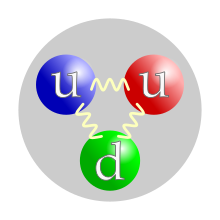| Revision as of 02:25, 28 July 2022 editCactiStaccingCrane (talk | contribs)24,860 edits stub outTags: Reverted Visual edit← Previous edit | Revision as of 02:53, 28 July 2022 edit undoCactiStaccingCrane (talk | contribs)24,860 edits →Quarks and leptons: using the latest editionTags: Reverted Visual editNext edit → | ||
| Line 26: | Line 26: | ||
| === Quarks and leptons === | === Quarks and leptons === | ||
| {{Main|Quark|Lepton}} | {{Main|Quark|Lepton}} | ||
| ] and one ], linked together by ]]] | ] consists of two ] and one ], linked together by ]]] | ||
| Most observable ] is composed of quarks and leptons.<ref name="Povh0">{{cite book |author=Povh |first=Bogdan |title=Particles and Nuclei: An Introduction to the Physical Concepts |author2=Rith |first2=Klaus |author3=Scholz |first3=Christoph |author4=Zetsche |first4=Frank |publisher=] |year=2014 |isbn=978-3-662-46320-8 |editor-last=Rodejohann |editor-first=Werner |edition=7th}}</ref> | |||
| === Bosons === | === Bosons === | ||
Revision as of 02:53, 28 July 2022
Branch of physics concerning the nature of particlesNot to be confused with Nuclear physics.

Particle physics (also known as high energy physics) is a branch of physics that studies the nature of the particles that constitute matter and radiation. Although the word particle can refer to various types of very small objects (e.g. protons, gas particles, or even household dust), particle physics usually investigates the irreducibly smallest detectable particles and the fundamental interactions necessary to explain their behaviour.
In current understanding, these elementary particles are excitations of the quantum fields that also govern their interactions. The currently dominant theory explaining these fundamental particles and fields, along with their dynamics, is called the Standard Model. Thus, modern particle physics generally investigates the Standard Model and its various possible extensions, e.g. to the newest "known" particle, the Higgs boson, or even to the oldest known force field, gravity.
History
Main article: History of subatomic physicsEarly developments
See also: Atomic theoryQuantum mechanics
Standard Model
Main article: Standard ModelSubatomic particles
Main articles: Subatomic particle and List of particlesQuarks and leptons
Main articles: Quark and Lepton
Most observable matter is composed of quarks and leptons.
Bosons
Main article: BosonAntiparticles and "color"
Main articles: Antiparticle and Color chargeComposite
Main article: Composite particleHypothetical
Fundamental interactions
Main article: Fundamental interactionQuantum fields
Main article: Quantum field theoryConservation laws
Further information: Conservation lawQuantum gravity problem
Main article: Quantum gravity Further information: String theory, Physics beyond the Standard Model, and Theory of everythingFacilities

See also
References
- "The Higgs Boson". CERN. Archived from the original on 21 August 2014. Retrieved 24 August 2014.
- "The BEH-Mechanism, Interactions with Short Range Forces and Scalar Particles" (PDF). 8 October 2013. Archived (PDF) from the original on 30 June 2018. Retrieved 14 June 2017.
- Povh, Bogdan; Rith, Klaus; Scholz, Christoph; Zetsche, Frank (2014). Rodejohann, Werner (ed.). Particles and Nuclei: An Introduction to the Physical Concepts (7th ed.). Springer Science+Business Media. ISBN 978-3-662-46320-8.
Further reading
- Introductory reading
- Close, Frank (2004). Particle Physics: A Very Short Introduction. Oxford University Press. ISBN 978-0-19-280434-1.
- Close, Frank; Marten, Michael; Sutton, Christine (2004). The Particle Odyssey: A Journey to the Heart of the Matter. Bibcode:2002pojh.book.....C. ISBN 9780198609438.
{{cite book}}:|journal=ignored (help) - Ford, Kenneth W. (2005). The Quantum World. Harvard University Press.
- Oerter, Robert (2006). The Theory of Almost Everything: The Standard Model, the Unsung Triumph of Modern Physics. Plume.
- Schumm, Bruce A. (2004). Deep Down Things: The Breathtaking Beauty of Particle Physics. Johns Hopkins University Press. ISBN 978-0-8018-7971-5.
- Close, Frank (2006). The New Cosmic Onion. Taylor & Francis. ISBN 978-1-58488-798-0.
- Advanced reading
- Robinson, Matthew B.; Bland, Karen R.; Cleaver, Gerald. B.; Dittmann, Jay R. (2008). "A Simple Introduction to Particle Physics". arXiv:0810.3328 .
- Robinson, Matthew B.; Ali, Tibra; Cleaver, Gerald B. (2009). "A Simple Introduction to Particle Physics Part II". arXiv:0908.1395 .
- Griffiths, David J. (1987). Introduction to Elementary Particles. Wiley, John & Sons, Inc. ISBN 978-0-471-60386-3.
- Kane, Gordon L. (1987). Modern Elementary Particle Physics. Perseus Books. ISBN 978-0-201-11749-3.
- Perkins, Donald H. (1999). Introduction to High Energy Physics. Cambridge University Press. ISBN 978-0-521-62196-0.
- Povh, Bogdan (1995). Particles and Nuclei: An Introduction to the Physical Concepts. Springer-Verlag. ISBN 978-0-387-59439-2.
- Boyarkin, Oleg (2011). Advanced Particle Physics Two-Volume Set. CRC Press. ISBN 978-1-4398-0412-4.
- Terranova, Francesco (2021). A Modern Primer in Particle and Nuclear Physics. Oxford Univ. Press. ISBN 978-0192845252.
| Major branches of physics | |
|---|---|
| Divisions | |
| Approaches | |
| Classical | |
| Modern | |
| Interdisciplinary | |
| Related | |
| Particles in physics | |||||||||||||||||||||||||
|---|---|---|---|---|---|---|---|---|---|---|---|---|---|---|---|---|---|---|---|---|---|---|---|---|---|
| Elementary |
| ||||||||||||||||||||||||
| Composite |
| ||||||||||||||||||||||||
| Quasiparticles | |||||||||||||||||||||||||
| Lists | |||||||||||||||||||||||||
| Related | |||||||||||||||||||||||||
| Fundamental interactions of physics | |
|---|---|
| Physical forces | |
| Hypothetical forces | |
| Standard Model | |||||||||
|---|---|---|---|---|---|---|---|---|---|
| Background |  | ||||||||
| Constituents | |||||||||
| Beyond the Standard Model |
| ||||||||
| Experiments | |||||||||
 Media from Commons
Media from Commons News from Wikinews
News from Wikinews Quotations from Wikiquote
Quotations from Wikiquote Resources from Wikiversity
Resources from Wikiversity